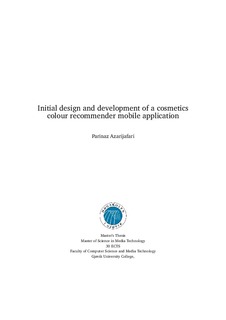Initial design and development of a cosmetics colour recommender mobile application
Master thesis
Permanent lenke
http://hdl.handle.net/11250/192958Utgivelsesdato
2013Metadata
Vis full innførselSamlinger
- Institutt for design [1129]
Sammendrag
This master thesis report contains the contribution to a beauty advisory mobile application design and development. The system was aimed to converge colour imaging science, new mobile technologies and a potential business within the cosmetics industry in order to provide recommendations on how to select the right cosmetic colour that matches best to one’s specific face skin. This project has been planned as a full digital beauty consultancy. However the core and starting point was to provide suggestions on selecting foundations, products of different formats such as liquid-based cream, powder or mousse, manufactured in human skin colour range to cover facial flaws. In this study, following the agile development principles, we mapped the user’s face skin colour to a series of foundation codes as the appropriate colour matches. The proposed method leading to these recommendations include performing colorimetric measurements on the foundations, employing a digital imaging system, colour image analysis, and colour difference calculations. User involvement as a key component throughout the design and development phase was fulfilled by surveying the users and integrating their feedbacks into the whole process. We were able to confirm that it is possible to use a foundation transparent bottle as a reference for colour calibration of the application pictures. Our experimental data resulted into promising recommendations while the system was tested under a controlled illumination and using a reasonably high quality camera. Whereas, in a more complex situation, under uncontrolled illumination using a mobile front-facing camera with low quality, having only one foundation bottle as colour reference; the helpfulness of the results dramatically decreased.
